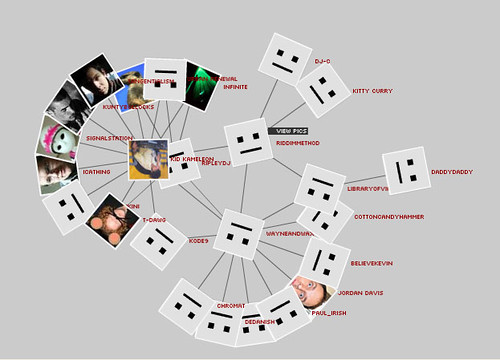Fickr webs

Riddimmethod-flickr graph c/o the nice people at flickr graph
From recent developments over at the Forest and the Trees blog, it feels as if the semantic web is just around the corner.
Doug has written an amazing new program called Findr, that searches through Flickr tags to find sets of photos representing the intersection of multiple tags. Doug describes it as Folksonomy + Interesection = Taxonomy. While he immediately downplays it, I think he is right on. His view is congruent with research in cognitive anthropology, and in particular, cognitive views of cultural meaning. In “A cognitive theory of cultural meaning” Strauss and Quinn (1997) argue that a cognitive/connectionist theory of meaning resolves long standing debates in cultural theory about the relationship between individual meaning making and culture (e.g., the age old debate between agency and structure). Strauss and Quinn (1997:82) define cultural meaning as follows:
"The meaning of an object or event for a person at a given time is the output of something like a connectionist network. The 'cultural meaning' of an object or event is the typical output of the networks of people who have similar histories"
While they have a specific idea in mind when they talk about a connectionist network, flickr/findr is “something like it” indeed. What makes Doug’s AP so fun is that it lets you play with groups of cultural categories (e.g., the collective output of individual mental models). Let me be more specific. When people tag things (in this case, photos), they are marking associations between the items and cognitive-cultural schemata. While these schemata are represented in individual minds, they are influenced by the experiences the individual has had in particular cultures/settings up to that point (as well as more idiosyncratic things like his/her mood, level of intoxication, activation level at the time, etc.). When you sort by tags, you are sorting by the collective output of a “kind of connectionist network”. If so, you should be able to learn something about the culture by playing with the associations among items.
I was pleasantly surprised when I started experimenting. Doing a general search like “people”, you can narrow down to smaller subsets by adding tags. For example, “people+clown+blackandwhite” gives predictable results. While this is cool (and better than flickr’s advanced search options due to the great visual interface, what is more interesting (and sometimes surprising) is the list of associated tags that appears below your current search. This list gives a flavor for the associated items in the cognitive schema most closely associated with the current search term/s.
However, it also works in reverse. You can learn something about the meaning of search terms by looking at the images associated with them. I tried putting in some descriptive, and slightly unusual words. “Dribble” for example, pulls up lots of pictures of babies, which tells you something about how that word gets associated with items at this time in the “culture” of flickr taggers. Because of Doug’s amazing graphical interface, it is easy to see patterns as they emerge. E.g., it’s easy to see the outlines of schemata emerge, and when they do, boy is it fun. It’s that process of intuitive, schema based exploration (paired with a nice graphical interface) that makes cognitive network data so sticky (e.g., fun). Don't believe me? Try flickr graph.

